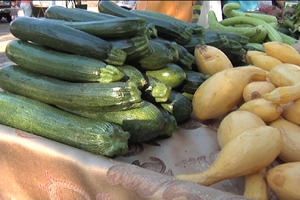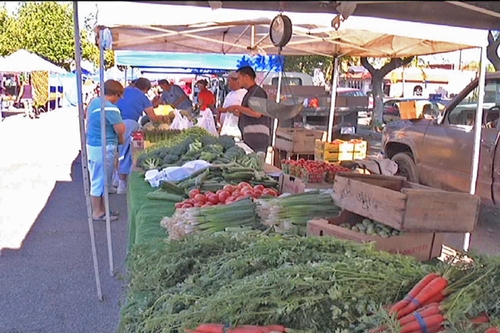Shopping for fruits and vegetables 'like we used to'
Shopping outdoors and having the chance to freely choose, ask questions, taste, and perhaps haggle a little are some of the reasons for immigrants from Latin America and elsewhere to find farmers markets particularly appealing. Childhood memories of going to open-air markets with their families are probably another big reason for them, but also for many older U.S. born consumers who are becoming regular customers.
Fortunately, as more non-Latinos and non-immigrants discover or re-discover the advantages of buying fresh produce grown by small farmers, we all will have more opportunities to enjoy getting our favorite fruits and vegetables "like we used to."
For my wife, Sylvia, and I is a lot more fun to buy our produce at our nearby farmers markets in Redlands and San Bernardino than shopping at the supermarket in our neighborhood. Going from stall to stall checking out what's offered is a totally different experience, and certainly more exciting. Unfortunately, these markets don't operate during the winter months, so we'll have to wait until next year.
We feel that we get more for our money at farmers markets. Eager to sell, vendors gladly greet you and talk to you as if you weren't a stranger to them. You feel invited to take a closer look at what they're selling. They try to show you that they care about you as an individual customer and want you to be happy with your purchase, just like it used to be before big supermarkets took over our food supply.
Not yet convinced? How about taking a bite of the fruit or vegetables that many vendors have always ready for you to sample? When was the last time they treated you like that at your local supermarket?
For my wife and I, that's the closest thing to going back in time when we went shopping at the produce markets of our childhoods, hers in Nicaragua, and mine in México. It's a tradition that can be traced to the Aztec's tianguis, as those ancient Mexicans called their open-air marketplaces.
Spanish conquerors were marveled at the wide and colorful array of fresh fruits, vegetables, and herbs sold at the indigenous marketplaces, as described by Bernardino de Sahagún in his Historia general de las cosas de la Nueva España (General History of the Things of New Spain). They found elotl (fresh corn) and teosintl (dry corn for tortillas and tamales), éxotl (green beans, also sold as dry beans) tomatl, (tomatos) ayotl (offered as zucchini and pumpkin), aguacatl (avocado), an enormous variety of chiles (peppers), and many other foods native to pre-colonial Latin America that now help to feed the world.
With the help of UCANR's Small Farm Program and its farm advisors, California growers continue to provide us with an ever-increasing variety of fruits and vegetables that are dear to the heart of immigrants from all corners of the world. Many of these can be found at farmers markets close to you.
Granted, the produce at open-air markets may not look as gorgeously tempting as the fruits and vegetables carefully polished and arranged at grocery stores. But my wife and other farmer market regulars swear by the flavor of the goods they get from these modern day nomadic food merchants.
You may have to pay a little more than at chain supermarkets that buy huge quantities of produce at very low prices from giant farms, which may be thousands of miles away or in other countries. But by purchasing at local farmers markets we get the feeling that we are helping to keep our state's agricultural tradition alive.
Buying produce grown at local farms is definitely a way to contribute to your own community. More than often, there's no question about who wins by shopping from these markets.
At a recent visit to the downtown San Bernardino farmers market my wife intended to buy only a few serrano peppers. After paying for them, she was surprised when the vendor gave her a full bag, more than two pounds of peppers!
"What would I do with all that?" she later told me. She took it home anyway and found a recipe to make Chiles encurtidos (pickled peppers). Next time you're this lucky, look for one of the many recipes for preserving fruits and vegetables on the Internet, and tips to preserve produce at home, including a short video with the do's and don'ts to prevent food poisoning.
Like most industries, farmers markets are well aware of demographics and are usually staffed by Spanish-speaking vendors; knowledgeable of Latino immigrants' customs, it's not uncommon for them, as they hand you the goodies that you've bought, to put an extra fruit or vegetable in the bag or in your hand as a token of appreciation.
"This one's for you," they'd say with wink and a smile.
Have you gotten one of those treats lately at your local supermarket?
Shoppers at the Redlands farmers market.
Comments:
y aunque soy medio mexicano y medio aleman la sangre es pura mexicana.....don Ricardo
Buena idea, Don Ricardo.
¡Muchísimas gracias!
Alberto.




Me das otra razon de sentirme orgullosa de compartir la misma sangre Latina.
Saludos y besos de tu amiga,
Maria :)
Posted by Maria de la Fuente on December 8, 2010 at 4:23 PM